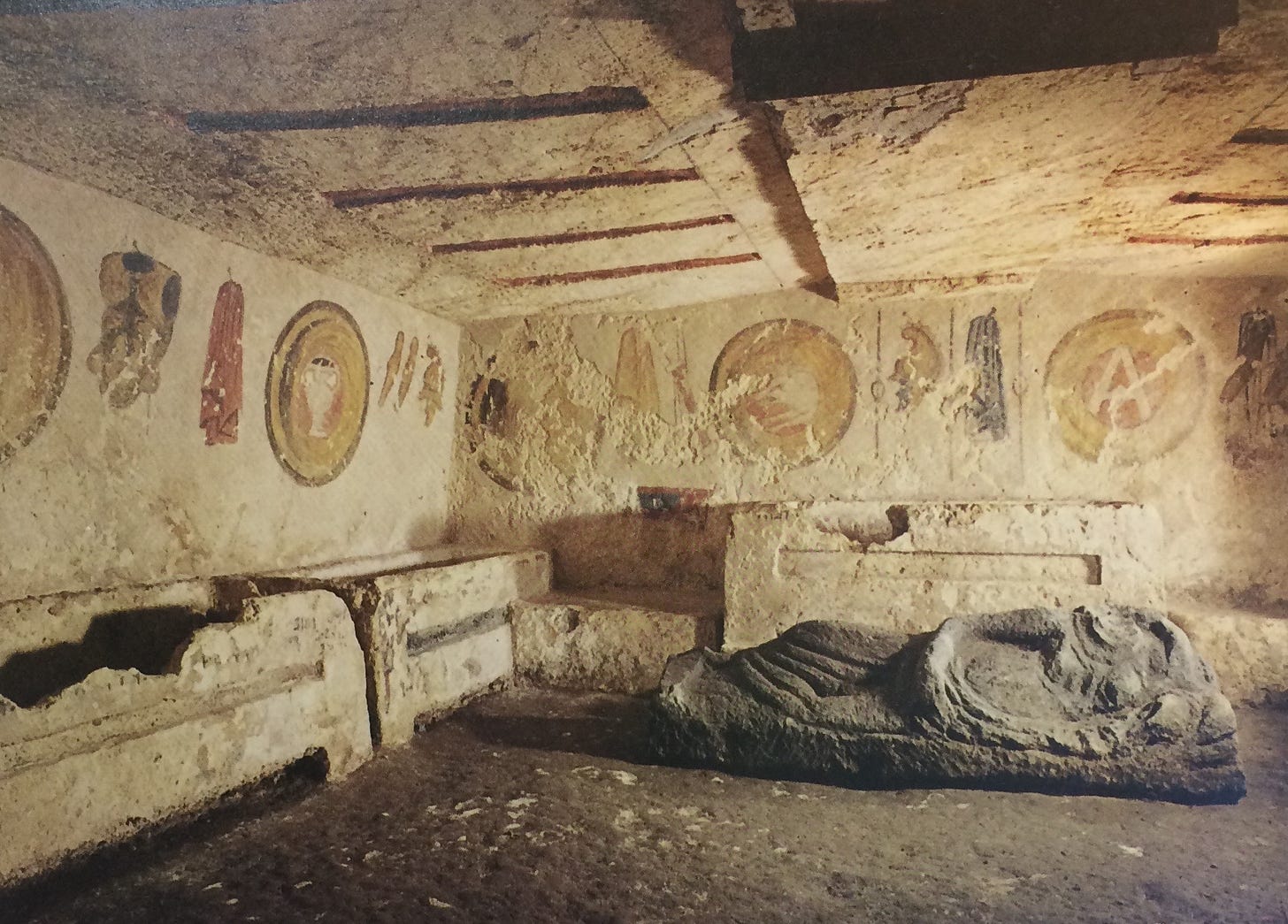Slings, Pila or Caducei?
A Note on Three Unusual Objects in the Painted Frieze of Arms and Armour in the Giglioli Tomb at Tarquinia

Back in 2012, I published a short article about the development of the pilum, the long-shanked javelin used by the Samnites, Romans, Etruscans and others. I referred to the apparent depiction of pila in the painted frieze of arms and armour in the Giglioli Tomb at Tarquinia (c. 300 BC), but noted that the shanks of the ‘javelins’ had an unusual twist and suggested “the objects may represent something other than weapons”. I was unable to include an illustration and referred readers to Stephan Steingraber’s Etruscan Painting.
In subsequent discussions, I decided that Peter Connolly was probably correct in identifying the objects as heavy pila, specifically of the flat-tanged variety. Connolly’s interpretation - first suggested in Hannibal and the Enemies of Rome - is more likely than Mauro Cristofani’s identification of the objects as slings. But one can understand Cristofani’s ID: the objects do have what could be pouches and twisted cords. However, if the objects represent slings, why do they appear to be rigid and propped up against the wall rather than hang from large nails like the other military equipment in the frieze?

Following Connolly’s interpretation, the objects are flat-tanged pila with shanks that taper to sharp points - a not uncommon feature of pila (albeit of the socketed type) in the fourth and early third centuries BC. The bulbous oval-shaped section between the shank and shaft clamps the flat tang, which is indicated by the vertical line running down the middle.
However, the earliest securely dated flat-tanged pilum shanks, the Roman examples from Telamon (225 BC), are short and have barbed heads, and the twist/rope-like spiral in the shanks of the Giglioli weapons is most unusual, if not unique, for pila of any era. Also, in contrast to the socketed pila depicted in the contemporary François Tomb at Vulci, there is no differentiation in colour between the what should be the wooden shafts and the metal shanks. The Giglioli objects are brown - dark on one side and lighter on the other (see here, note that the image is reversed).

Now, it is quite possible that pila with twisted shanks existed - but the ‘weapons’ in the Giglioli Tomb are remarkably similar to the caducei (ceremonial rods representing intertwined serpents) carried in the procession scene in the Tomb of the Typhon at Tarquinia (c. 275-250 BC). The resemblance between the ‘pila’ in the former and the caducei in the latter is striking.

The caduceus was the badge of the envoy and a symbol of peace. The frieze in the Giglioli Tomb is thought to glorify the deeds of the Pinie gens in Tarquinia’s wars against Rome. If the mystery objects are in fact caducei, this would suggest that the Pinie played a part not only in the fighting but were prominent also in the diplomacy that secured a truce with Rome in 308 BC (Livy 9.41).
Further Reading
P. Connolly, Hannibal and the Enemies of Rome (London 1978)
P. Connolly, Greece and Rome at War (London 1981; revised edition 2006)
R. Cowan, ‘The Samnite Pilum’, Ancient Warfare 6.4 (2012), 39-41
R. Cowan, ‘The Art of the Etruscan Armourer’ in J. Turfa (ed.), The Etruscan World (London 2013), 747-758
R. Cowan, ‘Etruscan and Gallic Pila’, Ancient Warfare 12.6 (2019), 18-21
M. Cristofani, ‘Il fregio d'armi della Tomba Giglioli di Tarquinia’, Dialoghi di Archeologia 1 (1967), 288-303 = M. Cristofani, Scripta Selecta II (Pisa & Rome 2001), 369-382
S. Steingraber, Etruscan Painting: Catalogue Raisonné of Etruscan Wall Paintings (New York 1986)

